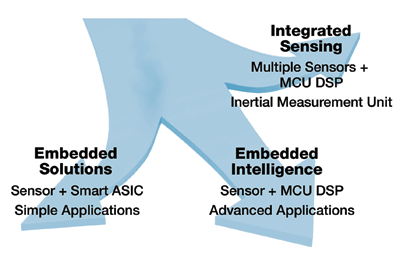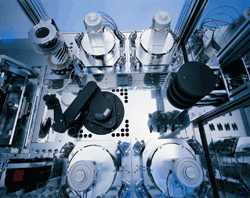Thoughts from the MEMS ecosystem
BY KAREN LIGHTMAN
MEMS Industry Group
Pittsburgh, PA
www.memsindustrygroup.org
MEMS (microelectromechanical systems) can help us to both sense the world around us and to actuate movement based on the information we gather. Motion control in applications such as the Nintendo Wii remote, the Apple iPhone, automotive airbags, and electronic stability control systems are just a few examples of MEMS in real-world applications.
Representing a total available market that analysts predict could reach between $9.8 billion by 2014 (iSuppli) and $16.4 billion by 2015 (Yole Développement), MEMS has far-reaching uses in mobile and wireless, automotive, bio/medical, industrial, and energy applications. While standalone MEMS devices fulfill many important application requirements, there are some instances in which integrating MEMS with DSP/microprocessors can take systems to the next level.
MEMS Industry Group (MIG) polled some of our member companies on the question, “When does it or doesn’t it make sense to pursue integration with processors?” We spoke with representatives from the MEMS industry ecosystem—leading device manufacturers, tools and equipment suppliers, and fabs — and received pragmatic answers to a multifaceted question.
When integration makes sense
Analog Devices (www.analog.com) makes low- and high-g MEMS accelerometers, gyroscopes, and microphones as well as digital signal processing ICs. Mark Martin, vice president of MEMS and Sensor Technology at Analog Devices, told us that “microprocessors or DSPs complement inertial sensors in a couple areas. First, processors can be used as a digital compensation engine handling the compensation formulas for correcting the inertial sensor for potential error sources, based on pre captured calibration constants; they can also be used for tuning to specific environments or application variables. The processor does the dynamic compensation. Second, processors can be used for backend processing [see Fig. 1 ], typically merging the inertial sensors with other system sensors in a function like a Kalman filter.”

Fig. 1. Processors can be used for backend processing when merged with inertial and other system sensors in a Kalman filter. (Photo courtesy of Analog Devices.)
An attractive scenario for integration, according to Martin, is high-performance applications where compensation processing tends to be most important.
Software algorithms make all the difference
We also spoke with Ed Brachocki, director of marketing at Kionix (www.kionix.com), which offers a family of MEMS devices with tri-axis accelerometers and gyroscopes along with mixed-signal-interface ICs that provide algorithm processing.
Brachocki sees integrating sensors with DSP/micros as a valuable solution for markets that have a broad range of customers requiring unique implementations of similar functions. He explained that algorithm development is a crucial step. By allowing customers to adapt the algorithm to their specific use conditions, sensor manufacturers extend the usability of their products. This algorithmic differentiation on the embedded DSP/micro lets multiple customers use out-of-the-box sensors for their applications and enables the sensor manufacturer to more easily adapt IP to specific customer requirements (see Fig. 2 ).

Fig. 2. Kionix defines three paths of sensor integration. (Photo courtesy of Kionix.)
Brachocki elaborated, “Software development is an increasingly complex variable associated with sensor integration. Offering a level of programmability to the customer gives system designers some flexibility early on in the hardware design process.”
Does integration make sense? It depends on whether the system architecture allows for main DSP/micros to perform the control and analysis of the sensors. “If the sensor functions are tightly coupled to the overall system function,” Brachocki explained, “there may be little benefit to having auxiliary processor control. But if, for example, you want to sample the sensor at a high rate, it may be better to let an embedded micro handle that.”
Work with your foundry early on
To get the foundry perspective, we turned to Stafford Johnson, engineering manager at MEMSCAP (www.memscap.com), a MEMS provider offering standard and custom components, component design IP, manufacturing, and related services. Johnson expressed the importance of customers engaging with MEMS foundries early in the design process to determine the best methodology for integration.
For example, the length and resistance of the wiring impacts system performance. If performance is a big concern, it may require special packaging to minimize the distance between electrical connections and the chips. Johnson suggests several options: a fully integrated custom CMOS/MEMS solution; flip-chip connection of MEMS to bare CMOS die; multi-chip modules; or PCB connections. If performance is not the overarching concern, then size, cost, manufacturability, and reliability become the focus of the packaging decisions.
How does one connect MEMS directly to a DSP/micro? “Again, we have some options,” Johnson says. “Low-power high-voltage electrostatic MEMS devices can interface to the MCU via a high-voltage driver, which controls the MEMS actuation. If the output from the MEMS is analog, an A/D converter, perhaps within the DSP/MCU, will be required.”
Johnson added that “the decision to integrate MEMS with DSP/micro depends on the application. While off-the-shelf components reduce costs and speed time-to-market, there are still instances in which custom solutions may be required. Whether it is size, high voltage requirements, special MEMS packaging requirements, or performance/reliability considerations, designers may need to develop custom electronics to achieve their objectives.”
The right equipment for MEMS/CMOS integration
Thorsten Matthias, global business development director at EV Group (EVG) (www.evgroup.com), a supplier of wafer bonding and lithography equipment for the MEMS, nanotechnology and semiconductor markets, completed another piece of the integration equation — manufacturing equipment required for MEMS-CMOS integration.
Matthias identified the integration of MEMS with CMOS as a major driver behind the implementation of 200-mm wafers for MEMS manufacturing. Demand for integration has been so high that EVG has offered bridge tools for 150 mm/200 mm for nearly a decade (see Fig. 3 ). EVG’s tools enable the rapid migration from one wafer size to another, allowing the processing of small lot sizes on a daily basis. EVG has also invested in new wafer bond processes and equipment, specifically for CMOS wafer capping and wafer-level processing (WLP).

Fig. 3. Since their inception, the Gemini systems have been bridge tools that can be equipped with either 150- or 200-mm tools. (Photo courtesy of EVG.)
It is not just MEMS companies who look to EVG for help, says Matthias, but IC customers who want to expand their portfolios by offering MEMS and CMOS: “MEMS provides attractive margins so many traditional CMOS manufacturers are including MEMS processes in their portfolio.” Demand for integration is growing stronger, says Matthias, and EVG is positioned to meet it.
Enabling the MEMS ecosystem
Coventor (www.coventor.com) supplies MEMS design tools based on finite element analysis and behavioral modeling for the development of micro- and nano-scale devices and systems. According to Steve Breit, vice president of engineering at Coventor, MEMS and DSPs are most likely to intersect at the functional, or algorithmic, level. MEMS devices output analog signals that undergo A/D conversion and then further processing on the DSP. In order to determine whether the complete system (MEMS, A/D, DSP, and software) meets the functional requirements, a system architect must simulate all components working together in a single environment. Coventor’s platform, MEMS+, supports the usual simulation tool of choice, MATLAB Simulink.
Based on market demand for integrated systems, Breit offers a prediction: “Looking ahead, we can expect increasing numbers of MEMS-enabled products that are mash-ups of DSPs, ASICS, and MEMS from different suppliers. The suppliers will include IDMs, fabless design houses, independent foundries, and equipment makers. Coventor expects MEMS+ to enable this MEMS ecosystem by providing both a common platform for specifying the MEMS design and a supply of models for the full range of design abstraction levels.”
MEMS expertise eases integration
Given the robust ecosystem of MEMS technology suppliers, there is no need to fear integration between MEMS and DSP/micros. Rather, there is every reason to tap the wealth of knowledge in the MEMS supply chain to get the job done right. ■
Advertisement
Learn more about MEMS Industry Group





